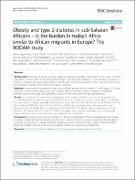| dc.contributor.author | Agyemang, Charles | |
| dc.contributor.author | Meeks, Karlijn | |
| dc.contributor.author | Beune, Erik | |
| dc.contributor.author | Dabo, Ellis Owusu | |
| dc.contributor.author | Mockenhaupt, Frank P | |
| dc.contributor.author | Addo, Juliet | |
| dc.contributor.author | Aikins, Ama de Graf | |
| dc.contributor.author | Bahendeka, Silver | |
| dc.contributor.author | Danquah, Ina | |
| dc.contributor.author | Schulze, Matthias B | |
| dc.contributor.author | Spranger, Joachim | |
| dc.contributor.author | Burr, Tom | |
| dc.contributor.author | Baffour, Peter Agyei | |
| dc.contributor.author | Amoah, Stephen K | |
| dc.contributor.author | Galbete, Cecilia | |
| dc.contributor.author | Henneman, Peter | |
| dc.contributor.author | Grobusch, Kerstin Klipstein | |
| dc.contributor.author | Nicolaou, Mary | |
| dc.contributor.author | Adeyemo, Adebowale | |
| dc.contributor.author | Straalen, Jan van | |
| dc.contributor.author | Smeeth, Liam | |
| dc.contributor.author | Stronks, Karien | |
| dc.date.accessioned | 2021-10-09T06:56:18Z | |
| dc.date.available | 2021-10-09T06:56:18Z | |
| dc.date.issued | 2016-10-21 | |
| dc.identifier.citation | Agyemang, C., Meeks, K., Beune, E., Owusu-Dabo, E., Mockenhaupt, F.P., Addo, J., de Graft Aikins, A., Bahendeka, S., Danquah, I., Schulze, M.B. and Spranger, J., 2016. Obesity and type 2 diabetes in sub-Saharan Africans–Is the burden in today’s Africa similar to African migrants in Europe? The RODAM study. BMC medicine, 14(1), pp.1-12. | en_US |
| dc.identifier.issn | 1741-7015 | |
| dc.identifier.uri | http://hdl.handle.net/20.500.12280/2842 | |
| dc.description.abstract | Background: Rising rates of obesity and type 2 diabetes (T2D) are impending major threats to the health of African
populations, but the extent to which they differ between rural and urban settings in Africa and upon migration to
Europe is unknown. We assessed the burden of obesity and T2D among Ghanaians living in rural and urban Ghana
and Ghanaian migrants living in different European countries.
Methods: A multi-centre cross-sectional study was conducted among Ghanaian adults (n = 5659) aged 25–70 years
residing in rural and urban Ghana and three European cities (Amsterdam, London and Berlin). Comparisons
between groups were made using prevalence ratios (PRs) with adjustments for age and education.
Results: In rural Ghana, the prevalence of obesity was 1.3 % in men and 8.3 % in women. The prevalence was
considerably higher in urban Ghana (men, 6.9 %; PR: 5.26, 95 % CI, 2.04–13.57; women, 33.9 %; PR: 4.11, 3.13–5.40)
and even more so in Europe, especially in London (men, 21.4 %; PR: 15.04, 5.98–37.84; women, 54.2 %; PR: 6.63, 5.04–8.72).
The prevalence of T2D was low at 3.6 % and 5.5 % in rural Ghanaian men and women, and increased in urban
Ghanaians (men, 10.3 %; PR: 3.06; 1.73–5.40; women, 9.2 %; PR: 1.81, 1.25–2.64) and highest in Berlin (men, 15.3 %;
PR: 4.47; 2.50–7.98; women, 10.2 %; PR: 2.21, 1.30–3.75). Impaired fasting glycaemia prevalence was comparatively
higher only in Amsterdam, and in London, men compared with rural Ghana.
Conclusion: Our study shows high risks of obesity and T2D among sub-Saharan African populations living in Europe.
In Ghana, similarly high prevalence rates were seen in an urban environment, whereas in rural areas, the prevalence
of obesity among women is already remarkable. Similar processes underlying the high burden of obesity and T2D
following migration may also be at play in sub-Saharan Africa as a consequence of urbanisation. | en_US |
| dc.language.iso | en | en_US |
| dc.publisher | BMC | en_US |
| dc.relation.ispartofseries | BMC medicine;14:166 | |
| dc.subject | Obesity | en_US |
| dc.subject | Type 2 diabetes | en_US |
| dc.subject | Migrants | en_US |
| dc.subject | Ethnic minority groups | en_US |
| dc.subject | Europe | en_US |
| dc.subject | Sub-Saharan Africa | en_US |
| dc.title | Obesity and type 2 diabetes in sub-Saharan Africans – Is the burden in today’s Africa similar to African migrants in Europe? The RODAM study | en_US |
| dc.type | Article | en_US |


